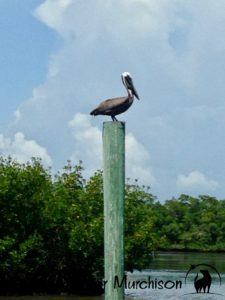
This day would mark our second year in a row to return to Sanibel Island. Our first priority was to collect seashells. It just occurred to me that THIS is the only type of hunting which I support. This year I’d bought us net bags that could be slipped on and worn while wading through the water. They were designed so that the shells remain but the sand goes right through the mesh enclosure. Among my under the sea discoveries was a pen shell. It still had its occupant residing in it so I returned it to its rightful home. The more I researched different types of shells the more fascinated I became … and the more ignorant I realized I was. Next we visited the J.N. “Ding” Darling National Wildlife Refuge where I got to hold a sea star (formally known as a starfish.) Established in 1976, it contains 5200 acres as part of the United States National Wildlife Refuge system, named for the cartoonist Jay Norwood “Ding” Darling. Protecting one of the country’s largest undeveloped mangrove ecosystems, the refuge is well known for its migratory bird populations. I took a picture of this guy, a local I’m guessing, as we made our way onto the boat that would take us around the wildlife sanctuary. I just loved him; he reminded me of a dignified butler allowing us passage into a grand estate from sometime long ago. During our boat ride we had the joy of seeing a pair of dolphins frolicking and playing for quite awhile alongside us. It’s like they knew they were safe and rose from the water to be seen without fear. What a thrill. The captain, who conducts daily excursions, even said this was a rare treat. There are over 245 different species of birds here. It is a refuge to turtles, amphibians, fish, and invertebrates. This was the sanctity of nature at its finest. Mammals ranging from manatees to raccoons also inhabit the island. The place was established to help protect endangered and threatened species. Located within an estuary, it creates some of the most nutritionally rich habitat for these thousands of species of plants and animals which call this refuge home. The mangrove forests and the seagrass beds provide the basis of their intricate food web. Jim Fowler, the American zoologist and host of the Emmy Award-winning television show “Mutual of Omaha’s Wild Kingdom” said, “The continued existence of wildlife and wilderness is important to the quality of life of humans.” For me, wildlife and wilderness for their own sake remain reason enough for going wild.
